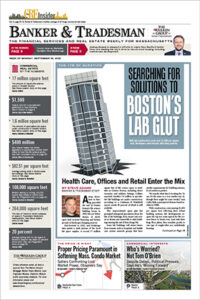The bulldozing of the old Boston Herald building may count as progress in some quarters – but not in my book, and not by a long shot.
The leveling of the long-time newspaper building, perched where the last development frontier of the South End meets Chinatown, is yet another step on the road to the Manhattanization of Boston, which is turning downtown Boston into a Potemkin village of luxury high-rises.
With the last piece of the old South End now fast on its way to becoming gentrified, the writing is on the wall for neighboring Chinatown.
But beyond the development implications, the end of the Boston Herald as we knew it for so many years, throwing bombs from its gritty piece of turf in the old Boston, is also a big loss for local journalism – especially for that increasingly rare breed of rough and ready reporting at which the Herald excelled.
It’s The Location, Stupid
It would be hard for me to get all misty-eyed about that sprawling, red brick dump of a building perched near the Southeast Expressway, even though it’s been a good four years since I walked out of the Herald and took the plunge into full-time freelancing.
As far as I know, OSHA never investigated health conditions in the building, which were positively Third World.
I added a good decade onto my life expectancy when I left, especially given the ever present “green soot” that had a nasty habit of drifting down from the dropped ceiling and onto the keyboards of our primitive Atex terminals – the best technology the Soviet Union ever invented, as we liked to joke back in not-so-old days.
“It was a lovable pit, sort of like the old Boston Garden,” writes Jay Fitzgerald, a former Herald colleague of mine, who recalls “ink-covered hallways, electrical wires hanging from ceilings, and filing cabinets that probably hadn’t been opened since the Eisenhower era.”
Needless to say, however amusing its many deficiencies, it wasn’t the building that made the Herald special. Rather, it was the inexhaustible supply of creative, insanely hardworking and lovably quirky reporters and editors that made the Herald the way it was, and, I guess, to some extent, still is.
That said, the Herald’s gritty location, perched next door to the Pine Street Inn, to me ranks as one of its secret weapons.
Yes, the Herald itself has opted to stay in Boston, with long-time owner Pat Purcell selling the building and moving the paper’s offices over to the Seaport. But sorry, sitting in an office next door to the new convention center in the Seaport, about as lively right now as a glorified industrial park, is just not the same thing.
Whether the story was crime or development, which was for years my beat, the Herald’s Harrison Avenue address could not be topped when it came to covering Boston. A quick jaunt – on foot, of course – through Chinatown and Downtown would put me at City Hall in 15 minutes, 20 at the most. A similarly short walk up East Berkeley would put you in the Back Bay.
Roxbury was a short drive in the opposite direction; South Boston could be reached after a five-minute walk across the Fort Point Channel.
By contrast, colleagues from our big daily competitor likely took a highway in from their semi-suburban locale, hunting for parking and missing out on everything in between.
If you are looking for stories, whether real estate development, crime or politics, nothing beats walking, and, when deadlines loomed, jogging across the city to meet them.
City Hall can spin all day about its supposed success turning around Downtown Crossing, but when you are walking through it each day with a skeptical eye, things look different. In fact, it was the same for any number of other stories, whether it was fears by Chinatown residents of being swallowed by encroaching luxury high-rises or the years-long struggle to move along various Roxbury redevelopment plans. Nothing beats being there, in the middle of things.
A Mini New York?
But the demise of the old Herald building is about more than just local journalism; it is a sign of the times for a city fast being remade in the image of a mini-Manhattan.
The Ink Block, the hip new apartment pad that will replace the old Herald building, will feature hundreds of pricey apartments in a pair of mid–rises, complete with a Whole Foods.
As significantly, it will gentrify one of the last undeveloped tracts of the South End, bringing the wave of upscale apartments, condos and shops right up to the border of beleaguered Chinatown.
In fact, the neighborhood already finds itself pressed equally hard, if not harder, from the other direction, with a frenzy of high-rise construction taking shape along the once-seedy Lower Washington Street.
Take another step back, and this wave of high-rise gentrification can be seen at work across downtown Boston, remaking the Back Bay, the Fenway, the South End, and parts of South Boston, as well.
It’s great if you have big bucks and want downtown Boston to be your private playground, but it’s probably a lot more mixed for the rest of us, and decidedly less favorable for the small businesses and the long-time residents of more modest means caught in this vise.
The sad thing is that it’s a trend that is well on the way to completion, with little or no deliberate debate over the past two decades, with outgoing Mayor Thomas M. Menino having ruled the local development scene with an increasingly iron fist.
For good or ill, the old Boston is breathing its last. And the demolition of the old Herald building is yet another milestone along the way.
Email: sbvanvoorhis@hotmail.com






